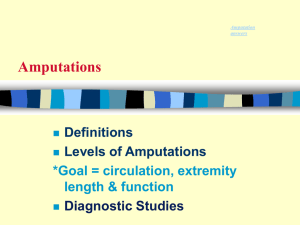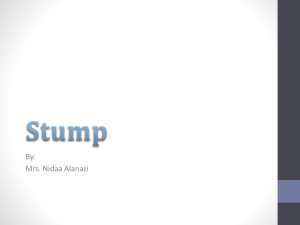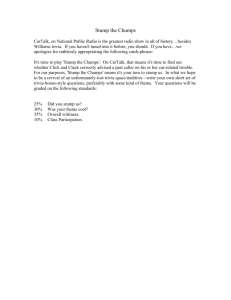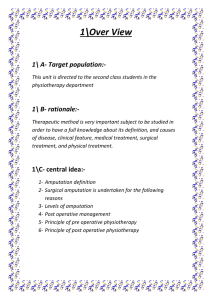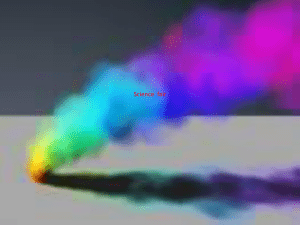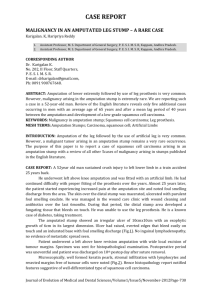Types of amputations
advertisement
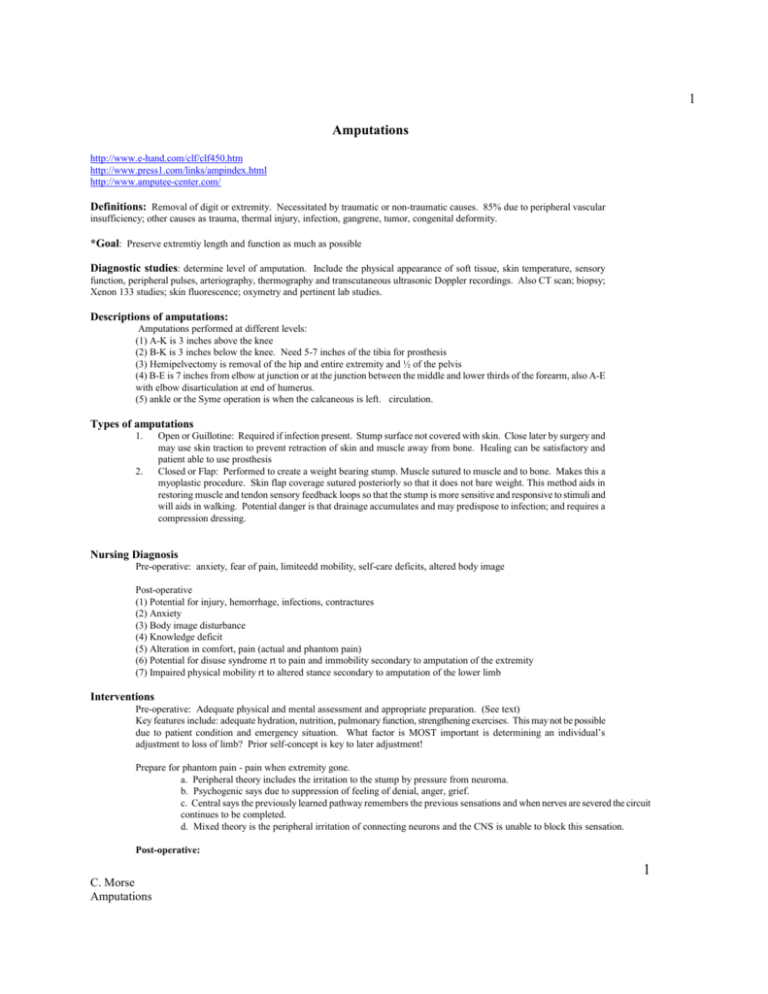
1 Amputations http://www.e-hand.com/clf/clf450.htm http://www.press1.com/links/ampindex.html http://www.amputee-center.com/ Definitions: Removal of digit or extremity. Necessitated by traumatic or non-traumatic causes. 85% due to peripheral vascular insufficiency; other causes as trauma, thermal injury, infection, gangrene, tumor, congenital deformity. *Goal: Preserve extremtiy length and function as much as possible Diagnostic studies: determine level of amputation. Include the physical appearance of soft tissue, skin temperature, sensory function, peripheral pulses, arteriography, thermography and transcutaneous ultrasonic Doppler recordings. Also CT scan; biopsy; Xenon 133 studies; skin fluorescence; oxymetry and pertinent lab studies. Descriptions of amputations: Amputations performed at different levels: (1) A-K is 3 inches above the knee (2) B-K is 3 inches below the knee. Need 5-7 inches of the tibia for prosthesis (3) Hemipelvectomy is removal of the hip and entire extremity and ½ of the pelvis (4) B-E is 7 inches from elbow at junction or at the junction between the middle and lower thirds of the forearm, also A-E with elbow disarticulation at end of humerus. (5) ankle or the Syme operation is when the calcaneous is left. circulation. Types of amputations 1. 2. Open or Guillotine: Required if infection present. Stump surface not covered with skin. Close later by surgery and may use skin traction to prevent retraction of skin and muscle away from bone. Healing can be satisfactory and patient able to use prosthesis Closed or Flap: Performed to create a weight bearing stump. Muscle sutured to muscle and to bone. Makes this a myoplastic procedure. Skin flap coverage sutured posteriorly so that it does not bare weight. This method aids in restoring muscle and tendon sensory feedback loops so that the stump is more sensitive and responsive to stimuli and will aids in walking. Potential danger is that drainage accumulates and may predispose to infection; and requires a compression dressing. Nursing Diagnosis Pre-operative: anxiety, fear of pain, limiteedd mobility, self-care deficits, altered body image Post-operative (1) Potential for injury, hemorrhage, infections, contractures (2) Anxiety (3) Body image disturbance (4) Knowledge deficit (5) Alteration in comfort, pain (actual and phantom pain) (6) Potential for disuse syndrome rt to pain and immobility secondary to amputation of the extremity (7) Impaired physical mobility rt to altered stance secondary to amputation of the lower limb Interventions Pre-operative: Adequate physical and mental assessment and appropriate preparation. (See text) Key features include: adequate hydration, nutrition, pulmonary function, strengthening exercises. This may not be possible due to patient condition and emergency situation. What factor is MOST important is determining an individual’s adjustment to loss of limb? Prior self-concept is key to later adjustment! Prepare for phantom pain - pain when extremity gone. a. Peripheral theory includes the irritation to the stump by pressure from neuroma. b. Psychogenic says due to suppression of feeling of denial, anger, grief. c. Central says the previously learned pathway remembers the previous sensations and when nerves are severed the circuit continues to be completed. d. Mixed theory is the peripheral irritation of connecting neurons and the CNS is unable to block this sensation. Post-operative: 1 C. Morse Amputations 2 General Interventions: 1. Prevent shock, hemorrhage by checking vital signs, have tourniquet, Ace, ready to rewrap. 2. Edema which can lead to neurovascular compromise by ice, elevate (24-48 hours) or preferably elevate the FOB. Do not elevate on pillow after 48-72 hour…cause contracture! 3. Loss of skin integrity. Avoid incontinence, wrap with saran. Keep clean and dry. 4. Prevent infection. Check for drainage, odor. 5. Pain. Medicate, prepare for the phantom pain, early ambulation, exercise of missing part, psychological support. Later deal with chronic pain as massage stump, eradicate neuromas. 6. Prevent contractures. Don't elevate, flexors very strong, flat bed, prone position, abduction and adductions exercises, isometrics. Gluteal, quadriceps, resistive with sling. Comparison with Immediate and Delayed Prosthesis , care varies slightly http://www.m-ind.com/sls/product/Gendo2.htm a. Delayed have stump dresses with Ace, stitches out at 2-3 weeks, then temporary prosthesis with full weight by six (6) weeks and at 10-12 may get permanent prosthesis. Hemorrhage, swelling are major post-operative problems. b. Immediate will have a total contact rigid dressing that protects the stump from injury by gentle compression of tissues to decrease edema and promote wound healing. Improves body image by waking with prosthesis and can weight bare by first post-op day at 25-30 pounds. No drains, check for slippage. Greatest danger is iinfection! Test Yourself! What crutch walking gait with BK Amputation? NWB=keep weaker leg off floor at all times; use 3 point gait.. Must have most strength and balance; patient moves weaker leg and both crutches forward at same time, shifts weight onto both hands resting on crutches then advances stronger leg. Partial and total wt bearing= patient supports 25% to 50% of body weight on weaker leg, with rest distributed between stronger leg and crutches. Nurse tell patient to keep heel of weak foot off floor, individual less likely to carry full body weight. TWB_ nurse instructs patient to distribute equal weight between each leg, minimal weight on crutches, normal walking step. Good to shift between slow and fast gaits. Gaits are either point gaits in which feet move forward as contact points on the floor or swing gaits in which feet swing forward. Point gaits slower, more stable. Point gaits=3 point, 4 point, 2 point Swing= swing to and swing through Teaching: The goal is to have a cone-shaped and well-healed stump. http://www.oandp.com/manuals/ Stump bandaging requires stump sock, warp with Ace which is used to decrease edema and increase collateral circulation, promote uniform muscle atrophy and keep the muscle firm. It is wrapped distal to proximal, secured at the waist, and use 4-6 inch Ace wraps. After the stump matures the bandage is used only when the prosthesis is not on. Need to wrap for one year. Keep same weight. Procedure: Be supine, limb fully extended or on unaffected side with knee and hip flexed for stability and the stump in hyperextension or can be in semi-setting position. Bandage medial to lateral on the anterior surface without circular turns and bring well in to groin and the spica part anchors to the body. Stump care: Bandage several times a day with clean bandages. Dry the elastic flat and don't hang, may use stump shrinker, light powder, inspect daily, wash with soap and water. No oils or alcohol. Put prosthesis on early and keep the prosthesis clean and dry. Maintain weight. Success depends on person's self-image, other health problems, appropriate referrals, and motivation. What instructions should the person be given about: (1) weight maintenance (2) temperature control What instructions should be given about (1) muscle strengthening (2) positioning of affected extremity (3) Types of prosthesis; care of prosthesis Upper extremity amputation: Mostly traumatic. Rare immediate prosthetic fitting. Hemorrhage a problem. Much edema. Pain severe. Exercises are assistive at first the ROM, shrugging shoulders, efforts to stand straight. Do ADL. Start bandaging when sutures out. 2 C. Morse Amputations 3 Requires very gently compression. Highly individualized prosthesis. Adjustment very difficult. Replantation http://www.emedicine.com/emerg/topic502.htm http://www.handtransplant.com/ http://www.biopharm-leeches.com/index.html (very comprehensive source) Definition : Reattacchment of amputated limb and/or body part! Criteria: Save person's life. Have different degrees of amputation as complete, incomplete with partial severing, but has circulation. Total replantation. Subtotal replantation. Factors considered: Number of fingers, toes, multiple digits, age, physical condition. Good if young, motivated, distal, clean cut. Unfavorable if over 30, proximal injury, avulsion, crush, smoker, concurrent disease Interventions Emergency care: Keep body part. Don't place in solution, put in sterile watertight container or plastic bag. Place on ice, don't freeze. Elevate stump. Use saline dressing. No tourniquet if can. Post-op care: Adequate circulation Watch for arterial occlusion, reflected by a pale color, slow capillary refill, cool temperature, and dermal bleeding shows serum, not blood. If venous occlusion, tissue will look blue, cyanotic with brisk capillary refill, have a distended appearance and will bleed briskly. a. Use of leeches can be helpful. Leeches have naturally produced anticoagulant, a local vasodilatation effect and a local anesthetic effect. Few disadvantages, natural flora is Aeromonads Hydrophila can cause infection. Leeches don’t attach if no arterial blood supply. Serve to remove congested blood and decrease venous congestion. Allows for marginal revascularization. Need good arterial blood flow. Used for 4-6 hours, post removal bleeding for 48 hours and up to 50 cc. They detach when full. Can reuse for same patient, but must regurgitate contents. Nurse must monitor, takes 10-15 minutes, then it drops off, place in alcohol; can’t let it migrate, prick to cause bleeding. b. Elevate extremity. c. Use Doppler. Monitor temperature for if less than 30 degrees centigrade, it reflects poor perfusion. Use oximeter. d. No smoking, drinking. e. Bed rest. f. Monitor signs and symptoms of infection. g. Continued psychological support. h. Use ASA, low weight dextran to decrease accumulation of platelets at the small vessels. Limb Salvage Bone grafting procedure referring to transfer of cancellous or cortical bone from one site to another. Bone can be from the patient (autogenic), another human (homogenic), (allographs), or another species (heterogenic). for lost or inadequately developed bone, or correct bony nonunion of fractures. 3 C. Morse Amputations
